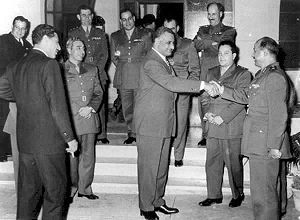
Back الأزمة السورية 1957 Arabic Κρίση της Συρίας (1957) Greek Sīrijas krīze (1957) Latvian/Lettish Crise Síria de 1957 Portuguese Сирійська криза (1957) Ukrainian
| 1957 Syrian Crisis | |||
|---|---|---|---|
| Part of the Cold War | |||
 | |||
| Date | 18 August – late October 1957 | ||
| Location | |||
| Resulted in | Turkey halts its border operations | ||
| Parties | |||
| Lead figures | |||
The Syrian Crisis of 1957 was a period of severe diplomatic confrontations during the Cold War that involved Syria and the Soviet Union on one hand, and the United States and its allies, including Turkey and the Baghdad Pact, on the other.
The tensions began on August 18,[1] when the Syrian government presided by Shukri al-Quwatli made a series of institutional changes, such as the appointment of Col. Afif al-Bizri as chief-of-staff of the Syrian Army, who was alleged by Western governments to be a Soviet sympathizer. Suspicion that a communist takeover had occurred in Damascus grew larger, prompting neighboring Iraq, Jordan and Lebanon to consider supporting an Arab or Western military intervention to overthrow the Syrian government. Turkey was the only country to step in by deploying thousands of troops along the Syrian-Turkish border. Nikita Khrushchev threatened that he would launch missiles at Turkey if it attacked Syria, while the United States said that it could attack the Soviet Union in response to an assault on Turkey. The crisis ended in late October, when Turkey agreed to cease its border operations following pressure by the United States,[2] and when Khrushchev made an unexpected visit to the Turkish embassy in Moscow.[1]
The events are widely seen as a major failure of the Eisenhower Doctrine, which stressed that the United States could intervene militarily on behalf of a Middle Eastern ally to fight "international communism".[2]
- ^ a b Brecher 1997, pp. 345–346.
- ^ a b Yaqub 2011, pp. 114–116.
© MMXXIII Rich X Search. We shall prevail. All rights reserved. Rich X Search